Excavation sites
Major archaeological sites in north and central China dating from the second millennium BC
The earliest and to-date most well known Shang site is Yinxu, near Anyang in Henan province. Work began in 1928 initially as an investigation of the source of oracle bones. It was carried out by a team from the new research organisation Academia Sinica, and directed by the Harvard-trained anthropologist Li Ji. Fifteen seasons of excavation were carried out at Anyang until 1937, when the Second Sino-Japanese War forced the archaeologists to evacuate. During that time, the Anyang excavators uncovered large pounded-earth (hangtu) architectural foundations, sacrificial burial cemeteries, and gigantic shaft tombs, not to mention caches of bronze vessels. Historians have come to associate the site with Yinxu, the traditional name of the Shang capital for the last twelve kings of the dynasty, starting with Pan Geng. Excavations at Anyang resumed in 1950, under the auspices of a new Institute of Archaeology, and a permanent field station was established there in 1958.
The successes at Anyang encouraged further archaeological efforts, awareness of which has been fostered by the State Bureau of Cultural Relics. In 1952, excavations at Erligang, near Zhengzhou, disclosed the remains of a walled city at least as large as Anyang, but from a demonstrably earlier period. Excavations were difficult, however, because the ancient city lay beneath the modern one.
The still older site of Erlitou, near Luoyang, was discovered in 1959 by a survey prospecting for Xia remains. The three sites of Erlitou, Erligang, and Anyang have been taken to provide a complete chronological sequence for the early Bronze Age in China.
There have also been other finds away from the Yellow River valley. A significant early achievement was the discovery of an Erligang-period city at Panlongcheng, not far from the Yangzi River. Further and more distinct finds surfaced later in the middle and lower Yangzi regions, including the Wucheng site in Jiangxi, suggesting local civilisations separate from those of the Yellow River region. This argument has grown stronger with the discoveries further afield – that of spectacular sacrificial pits at Sanxingdui, Sichuan in 1986, and of a rich tomb at Xingan, Jiangxi, in 1989.

The Shang dynasty, also known as the Yin dynasty, was a Chinese royal dynasty that ruled in the Yellow River valley during the second millennium BC, traditionally succeeding the Xia dynasty and followed by the Western Zhou dynasty. The classic account of the Shang comes from texts such as the Book of Documents, Bamboo Annals and Records of the Grand Historian. Modern scholarship dates the dynasty between the 16th and 11th centuries BC, with more agreement surrounding the end date than beginning date.

Oracle bones are pieces of ox scapula and turtle plastron which were used in pyromancy – a form of divination – during the Late Shang period in ancient China. Scapulimancy is the specific term if ox scapulae were used for the divination, plastromancy if turtle plastrons were used. A recent count estimated that there were about 13,000 bones with a total of a little over 130,000 inscriptions in collections in China and some fourteen other countries.

Yinxu is a Chinese archeological site corresponding to Yin, the final capital of the Shang dynasty. Located in present-day Anyang, Henan, Yin served as the capital during the Late Shang period which spanned the reigns of 12 Shang kings and saw the emergence of oracle bone script, the earliest known Chinese writing. Along with oracle bone script and other material evidence for the Shang's existence, the site was forgotten for millennia. Its rediscovery in 1899 resulted from an investigation into oracle bones that were discovered being sold nearby. The rediscovery of Yinxu marked the beginning of decades of intensive excavation and study. It is one of China's oldest and largest archeological sites, and was selected by UNESCO as a World Heritage Site in 2006. Yinxu is located in northern Henan, near modern Anyang and the borders Henan shares with Hebei and Shanxi. Public access to the site is permitted.
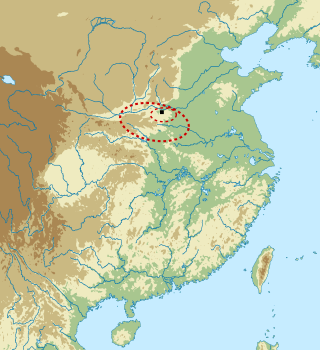
The Erlitou culture was an early Bronze Age society and archaeological culture. It existed in the Yellow River valley from approximately 1900 to 1500 BC. The culture is named after Erlitou, an archaeological site in Yanshi, Henan. It was widely spread throughout Henan and Shanxi and later appeared in Shaanxi and Hubei. Most archaeologists consider Erlitou the first state-level society in China. Chinese archaeologists generally identify the Erlitou culture as the site of the Xia dynasty, but there is no firm evidence, such as writing, to substantiate such a linkage, as the earliest evidence of Chinese writing dates to the Late Shang period.

The Erligang culture is a Bronze Age urban civilization and archaeological culture in China that existed from approximately 1600 to 1400 BC. The primary site, Zhengzhou Shang City, was discovered at Erligang, within the modern city of Zhengzhou, Henan, in 1951.
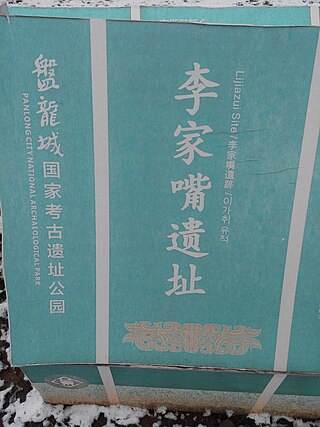
Panlongcheng or Panlong City is an archaeological site associated with the Erligang culture during the Shang dynasty period. The site is located just north of the Yangtze river, on the bank of the Panlong lake, and is surrounded by the Fushui river in Huangpi, Wuhan, Hubei, China. Panlongcheng is the largest excavated Erligang site, showing the southernmost reach of the Erligang culture at its peak. It was discovered in 1954, and excavated in 1974 and 1976.

The Dayangzhou Chengjia site is an archaeological site located on the Gan River in Dayangzhou Town, Xingan County, Jiangxi, China. The site was excavated in 1989, and it dates to around 1200 BCE. The rich offerings of bronze and jade objects made it the second richest burial site known after the Fu Hao's tomb.
The Wucheng culture (吳城文化) was a Bronze Age archaeological culture in Jiangxi, China. The initial site, spread out over 4 km2 (1.5 sq mi), was discovered at Wucheng Township, Jiangxi. Located on the Gan River, the site was first excavated in 1973. The Wucheng culture probably developed in response to cultural contacts with the expanding Erligang culture, melding Erligang influences with local traditions. The Wucheng culture was a distinct contemporary of Sanxingdui and Yinxu (Anyang).
The Xia–Shang–Zhou Chronology Project was a multi-disciplinary project commissioned by the People's Republic of China in 1996 to determine with accuracy the location and time frame of the Xia, Shang, and Zhou dynasties.

A jia is a ritual vessel type found in both pottery and bronze forms; it was used to hold libations of wine for the veneration of ancestors. It was made either with four legs or in the form of a tripod and included two pillar-like protrusions on the rim that were possibly used to suspend the vessel over heat. The earliest evidence of the Jia vessel type appears during the Neolithic Period. It was a prominent form during the Shang and early Western Zhou dynasties, but had disappeared by the mid-Western Zhou.

The Zhengzhou Shang City is an archaeological site of the Bronze Age Erligang culture in Zhengzhou, Henan, China. Studies give it 4 chronological phases from 1630 to 1400 BC. The excavation of the site is of great importance in understanding the history of the dynasty. It is also one of the oldest archeological sites in China.
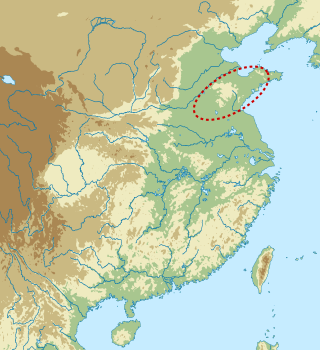
The Yueshi culture was an archaeological culture in the Shandong region of eastern China, dated from 1900 to 1500 BC. It spanned the period from the Late Neolithic to the early Bronze Age. In the Shandong area, it followed the Longshan culture period and was later replaced by the Erligang culture.
The Zhou–Chu War was a military conflict between the Zhou dynasty under King Zhao and the state of Chu from 961 to 957 BC. King Zhao personally led at least two major campaigns against Chu and other states and tribes of the middle Yangtze region, initially conquering the lands north of the Yangtze and the Han River valley. Eventually, however, the Zhou forces suffered a crushing defeat, with half of their armed forces as well as King Zhao killed, subsequently losing control of much conquered territory. The war ended the era of Western Zhou's early expansion and forced it into the defense against foreign aggressors. On the other side, Chu consolidated its de facto independence and would continue to grow into one of the most powerful states of China.

In 2001, the Institute of Archaeology of the Chinese Academy of Social Sciences organized a poll for China's 100 major archaeological discoveries in the 20th century. The participants included eight national-level institutions for archaeology and cultural relics, provincial-level archaeological institutes from 28 provinces, municipalities, and autonomous regions, as well as from Hong Kong, the archaeological departments of 11 major national universities, and many other scholars in Beijing. After three months and three rounds of voting, the results were announced on 29 March 2001 and were published in the journal Kaogu (Archaeology). In 2002, the Chinese Academy of Social Sciences Press published the book China's 100 Major Archaeological Discoveries in the 20th Century (二十世纪中国百项考古大发现), with more than 500 pages and 1,512 pictures.
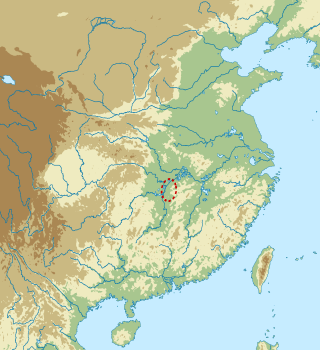
The Feijiahe culture, also known as Zhangshutan-Feijiahe culture or Duimenshan-Feijiahe, is a Bronze Age archaeological culture in China. It has been commonly dated to approximately 1300 to 1000 BC. Centered in the area east of Dongting Lake, the Feijiahe culture was a post-Erligang culture marked by the increase of localized traditions.
The earliest human occupation of what is now China dates to the Lower Paleolithic c. 1.7 million years ago—attested by archaeological finds such as the Yuanmou Man. The Erlitou and Erligang cultures inhabiting the Yellow River valley were Bronze Age civilizations predating the historical record—which first emerges c. 1250 – c. 1200 BCE at Yinxu, during the Late Shang.
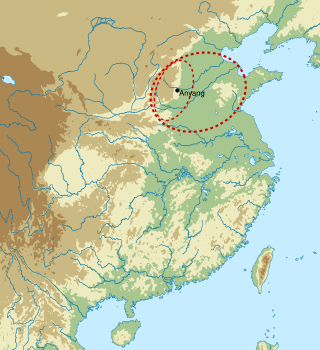
The Late Shang, also known as the Anyang period, is the earliest known literate civilization in China, spanning the reigns of the last nine kings of the Shang dynasty, beginning with Wu Ding in the second half of the 13th century BC and ending with the conquest of the Shang by the Zhou in the mid-11th century BC. The state is known from artifacts recovered from its capital at a site near Anyang now known as Yinxu and other sites across the North China Plain. One of the richest finds was the Tomb of Fu Hao at Yinxu, thought to belong to a consort of Wu Ding mentioned in Shang inscriptions.
Guandimiao is a Chinese archaeological site 18 km south of the Yellow River in Xingyang, Henan. It is the site of a small Shang dynasty village that was inhabited from roughly 1250 to 1100 BCE during the Late Shang period. Located 200 km from the Shang capital at Yinxu, the site was first studied as a part of excavations undertaken between 2006 and 2008 in preparation for the nearby South–North Water Transfer Project. Excavation and study at Guandimiao has significantly broadened scholars' understanding of rural Shang economies and rituals, as well as the layout of rural villages, which have received comparatively little attention in the field of Shang archaeology compared to urban centers like Yinxu and Huanbei.
Daxinzhuang is a Chinese archaeological site located near Daxinzhuang village in Licheng, Jinan, Shandong. Although early occupation in the vicinity has been dated to the Neolithic Longshan and Yueshi culture, the site became an urban center during the late Erligang, corresponding to a period of political and military expansion from the heartland of Henan into Shandong. Daxinzhuang became the type site of the Daxinzhuang type, a material culture type shared by other settlements along the Ji River.
The periodization of the Shang dynasty is the use of periodization to organize the history of the Shang dynasty in ancient China. The Shang dynasty was a Chinese royal dynasty that ruled in the Yellow River valley for over 500 years, traditionally succeeding the Xia dynasty and followed by the Zhou dynasty. According to the conventional narrative of later transmitted texts, the Shang clan, led by their great leader Tang, defeated Jie of the Xia dynasty and founded a new dynasty known as Shang. The Shang moved their capital several times during the existence of the dynasty, eventually settling in a place called Yin, later known in the transmitted texts as Yinxu, located on the outskirts of the modern city of Anyang. It was eventually conquered by the Predynastic Zhou led by King Wu following the Battle of Muye in ca. 1046 BC, which led to the establishment of the Western Zhou dynasty. Scholars divide the Shang dynasty into periods for convenience, usually relating to the location of the dynasty's capital.














